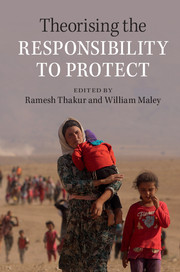Book contents
- Frontmatter
- Contents
- List of figures
- Notes on contributors
- Part I Context
- Part II The Responsibility to Protect, normative theory and global governance
- Part III The Responsibility to Protect and international social purposes
- 12 United Nations peacekeeping and the Responsibility to Protect
- 13 Humanitarian law, refugee protection and the Responsibility to Protect
- 14 Is the Responsibility to Protect doctrine gender-neutral?
- 15 The Responsibility to Protect: a Western idea?
- 16 Colonialism and the Responsibility to Protect
- Index
13 - Humanitarian law, refugee protection and the Responsibility to Protect
from Part III - The Responsibility to Protect and international social purposes
Published online by Cambridge University Press: 05 August 2015
- Frontmatter
- Contents
- List of figures
- Notes on contributors
- Part I Context
- Part II The Responsibility to Protect, normative theory and global governance
- Part III The Responsibility to Protect and international social purposes
- 12 United Nations peacekeeping and the Responsibility to Protect
- 13 Humanitarian law, refugee protection and the Responsibility to Protect
- 14 Is the Responsibility to Protect doctrine gender-neutral?
- 15 The Responsibility to Protect: a Western idea?
- 16 Colonialism and the Responsibility to Protect
- Index
Summary
The development since 2001 of the doctrine of the Responsibility to Protect (R2P) has been one of the most important normative developments in international relations in the last century. At a truly remarkable pace, it has moved from being an idea articulated by the International Commission on Intervention and State Sovereignty to a principle endorsed by leaders of United Nations member states at the World Summit in 2005, and given further substance by its employment to justify protective action for the population of Libya at the time of the overthrow of the Gaddafi regime, although the precise import of this particular case remains open for debate.
Nonetheless, it is but one of a range of norms that have appeared in the last century and a half with a view to offering some kind of protection to people in vulnerable situations. The establishment in 1863 of the International Committee of the Red Cross (ICRC) was one event of fundamental importance in highlighting the need for protection of the vulnerable: the stimulus for the ICRC's establishment was the carnage on the battlefield of Solferino that had been witnessed by Jean-Henry Dunant when by chance he found himself in the vicinity of combat, and which he documented in a famous memoir. The corpus of international humanitarian law, also known as the law of armed conflict, that has developed since then provides critical protections for those in the firing line in armed combat. Another kind of protective regime is that which exists for the benefit of those forced to flight by a well-founded fear of being persecuted. The 1951 Convention Relating to the Status of Refugees is an important source of normative obligation in this respect, but it is only one part of a wider regime augmented by other instruments, and by institutions such as the Office of the United Nations High Commissioner for Refugees.
This chapter is concerned with a particular theoretical problem, namely how parallel but distinct norms can come into conflict with each other. It is easy to assume that norms with a broadly similar humanitarian impetus will prove complementary, but that need not be the case. The reason for this is that norms are implemented in a highly political environment in which considerations of domestic politics may dispose rulers to seek ways of avoiding responsibilities that their predecessors may have voluntarily accepted.
- Type
- Chapter
- Information
- Theorising the Responsibility to Protect , pp. 249 - 265Publisher: Cambridge University PressPrint publication year: 2015
- 2
- Cited by



